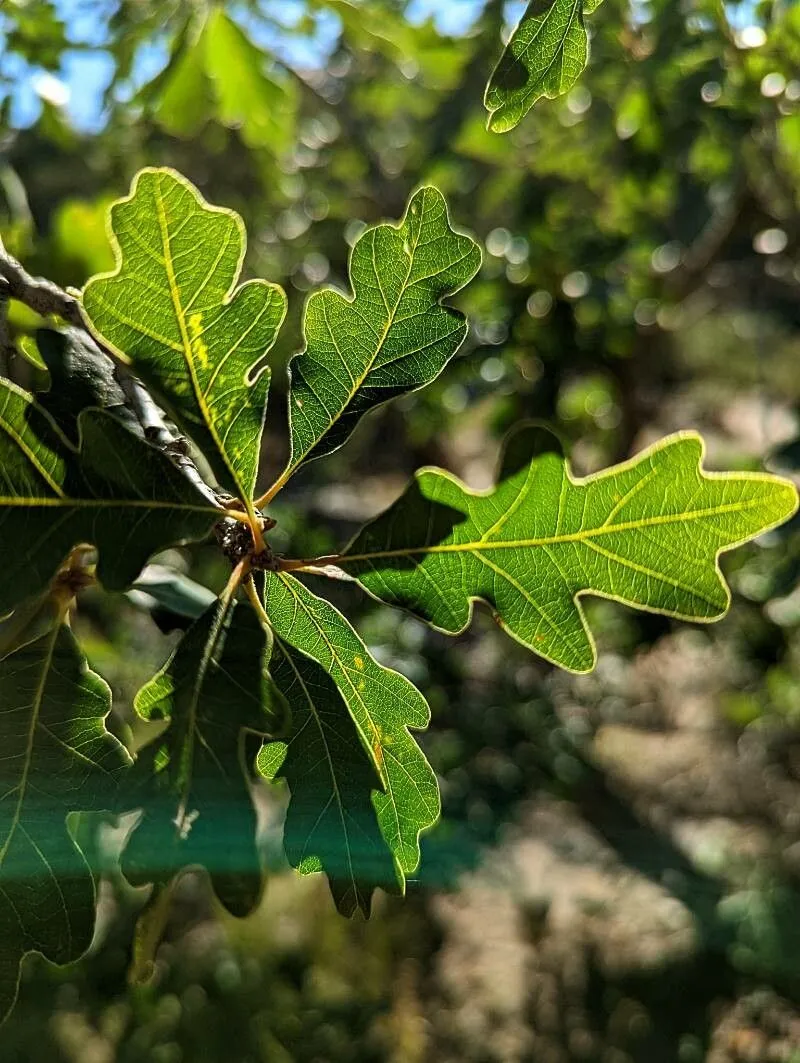
Author: Nutt.
Bibliography: J. Acad. Nat. Sci. Philadelphia 1: 179 (1847)
Year: 1847
Status: accepted
Rank: species
Genus: Quercus
Vegetable: Unknown
Observations: WC. & SC. U.S.A. to N. Mexico
The Gambel oak, known scientifically as Quercus gambelii, is a distinguished member of the Fagaceae family. This resilient and adaptable shrub or small tree is native to the western and southwestern regions of the United States, extending into northern Mexico. First described by Nuttall in the Journal of the Academy of Natural Sciences of Philadelphia in 1847, the Gambel oak thrives across a diverse range of landscapes, from woodlands to scrublands.
Characteristically, the Gambel oak exhibits a rugged, shrubby appearance, often forming dense thickets but sometimes growing as a solitary tree reaching heights of up to 30 feet. Its bark is typically rough and gray, providing a textured contrast to the glossy, deep green leaves. The leaves themselves are deeply lobed, creating a distinctive, almost hand-like silhouette that turns to stunning hues of red and orange in the autumn, adding seasonal beauty to its habitat.
Ecologically, Quercus gambelii plays a vital role in its native ecosystems. It serves as a crucial food source for various wildlife, including deer and livestock, which browse its leaves, and numerous bird species that feed on its acorns. These acorns also support the regeneration of new oak saplings, ensuring the continuity of the species.
The adaptability of the Gambel oak allows it to withstand varying environmental conditions, from the high elevations of mountain ranges to the arid conditions of lower elevations. This adaptability also extends to its soil preferences; while it prospers in well-drained soils, the oak’s extensive root system enables it to survive in poor, rocky substrates, making it a robust contender in the plant kingdom.
Gambel oak vegetation provides more than just aesthetic and ecological value; it contributes to the stabilization of soil in erosion-prone areas and offers shade and shelter to numerous species, thereby maintaining the ecological balance of its environment. Its ability to resprout after fire makes it a resilient presence in fire-prone landscapes, perpetuating its role as a foundational species in many North American woodlands.
In conclusion, the Gambel oak, Quercus gambelii, stands out not only for its distinctive physical attributes and seasonal beauty but also for its significant contributions to the ecosystems of the western and southwestern United States and northern Mexico. From its resilient growth habits to its role in supporting wildlife, this oak species epitomizes the rugged beauty and ecological importance of the regions it inhabits.
Eng: gambel oak, gambel’s oak, scrub oak
En: Gambel oak, Gambel’s oak, Scrub Oak
Taken Aug 31, 2014 by EOL − Zoya Akulova (cc-by-nc)
Taken Aug 31, 2014 by EOL − Zoya Akulova (cc-by-nc)
Taken Jul 5, 2022 by B M (cc-by-sa)
Taken Jul 5, 2022 by B M (cc-by-sa)
Taken Aug 18, 2022 by Layla Warren (cc-by-sa)
Taken Jul 5, 2014 by EOL − Christopher Tracey (cc-by-nc-sa)
Taken Nov 2, 2015 by EOL − ellen hildebrandt (cc-by-nc)
Taken Aug 29, 2012 by EOL − Cavender-Bares, J. (cc-by-nc-sa)
Taken Sep 21, 2012 by EOL − Derek Hansen (cc-by)
Taken May 16, 2022 by Dieter Albrecht (cc-by-sa)
Taken Aug 31, 2014 by EOL − Zoya Akulova (cc-by-nc)
Taken Aug 1, 2002 by EOL − Steven J. Baskauf (cc-by-nc-sa)
Taken Sep 11, 2013 by EOL − Amy Jewitt (cc-by-nc)
Taken Aug 31, 2014 by EOL − Zoya Akulova (cc-by-nc)
Taken May 16, 2022 by Dieter Albrecht (cc-by-sa)
Taken May 15, 2019 by Jose Cortez (cc-by-sa)
Taken Oct 12, 2021 by Lisa Goldner (cc-by-sa)
Taken Sep 4, 2022 by Cathy Polaris (cc-by-sa)
Taken May 16, 2022 by Dieter Albrecht (cc-by-sa)
Taken May 16, 2022 by Dieter Albrecht (cc-by-sa)
Taken May 16, 2022 by Dieter Albrecht (cc-by-sa)
Taken May 16, 2022 by Dieter Albrecht (cc-by-sa)
Taken Sep 21, 2012 by EOL − Derek Hansen (cc-by)
Taken Sep 21, 2012 by EOL − Derek Hansen (cc-by)
Taken Sep 21, 2012 by EOL − Derek Hansen (cc-by)
Taken Sep 21, 2012 by EOL − Derek Hansen (cc-by)
Taken Sep 21, 2012 by EOL − Derek Hansen (cc-by)
© copyright of the Board of Trustees of the Royal Botanic Gardens, Kew.
Family: Myrtaceae Author: (F.Muell.) K.D.Hill & L.A.S.Johnson Bibliography: Telopea 6: 402 (1995) Year: 1995 Status:…
Family: Rubiaceae Author: Pierre ex A.Froehner Bibliography: Notizbl. Bot. Gart. Berlin-Dahlem 1: 237 (1897) Year:…
Family: Sapindaceae Author: Koidz. Bibliography: J. Coll. Sci. Imp. Univ. Tokyo 32(1): 38 (1911) Year:…
Family: Asteraceae Author: A.Gray Bibliography: Pacif. Railr. Rep.: 107 (1857) Year: 1857 Status: accepted Rank:…
Family: Fabaceae Author: Medik. Bibliography: Vorles. Churpfälz. Phys.-Ökon. Ges. 2: 398 (1787) Year: 1787 Status:…
Family: Aspleniaceae Author: (Cav.) Alston Bibliography: Bull. Misc. Inform. Kew 1932: 309 (1932) Year: 1932…